West Africa Grand Expedition, Dakar - Cotonou
35 Days: Senegal, Gambia, Guinea Bissau, Guinea Conakry, Sierra Leone, Liberia, Ivory Coast, Ghana, Togo and Benin
Leaded by Alberto Nicheli
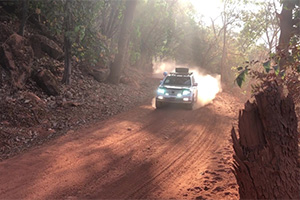
Duration: 35 days
Area: Senegal, Gambia, Guinea Bissau, Guinea Conakry, Sierra Leone, Liberia, Ivory Coast, Ghana, Togo and Benin
Style: adventurous expedition, cultural tour
Comfort Level:![]()
![]()
![]()
![]()
![]()
West Africa Grand Expedition
Dakar - Cotonou
35 Days: Senegal, Gambia, Guinea Bissau, Guinea Conakry, Sierra Leone, Liberia, Ivory Coast, Ghana, Togo and Benin
Leaded by Alberto Nicheli
Unique Departures:
- From Dakar December 3th, 2020. Ends in Cotonou Jannuary 6th, 2021.
- From Cotonou February 26th, 2021. Ends in Dakar April 1st, 2021. Reverse Itinerary
Prices from 8,758 Euro
Or join us for part of the Expedition: itineraries from 6 to 30 days
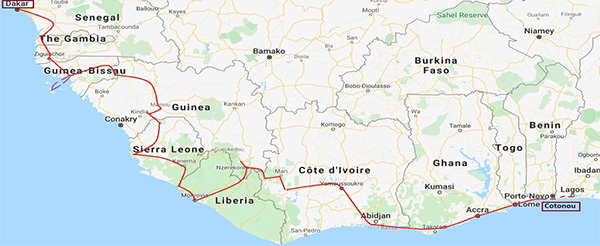
Introduction
Starting from Cap d’Almadine in Dakar, the western point of African continent. Going South and East: Gambia and his birds, Casamance and the animistic mask dances, navigating to Bijagos remote Archipelago, discovering the les known part of Guinea Bissau with a “tribal concert” of the Griot: descendent of traditional musician and story tellers lineage uninterrupted from 12th century. Following the coast and inland of Guinea Gulf, between pristine shores and islands. Experience remotes forests where foreigners don’t arrive: mountains, liana bridges, isolated villages house of Bird Men initiates, dancing masks, secrete animistic rituals and diamonds seekers. Witness the highest concentration of ancient trade and slave castles. Discover the African origins of Voodoo: trance rituals still practiced in the largest stilt village of the continent.
Participate to the contemporary African vibe: stroll in the intense city life of Dakar, Freetown, Monrovia, Abidjan and Accra, feel the exciting mix of modernity, culture, music and fusion cuisine.
The Grand Traverse across West Africa will be adventurous and enjoyable. Transport in in comfortable air-conditioned 4WD vehicles and minibuses. On Ocean and lagoons: speed boats for major navigations and local boat for short sails.
Accommodations: in the capitals, 4 stars hotels with possibility to upgrade to 5 stars. In the inland the best available: mainly new 3 stars hotels with self-contain and air-conditioned rooms. One night at a fix and cosy camp in the luxuriant vegetation of an island.
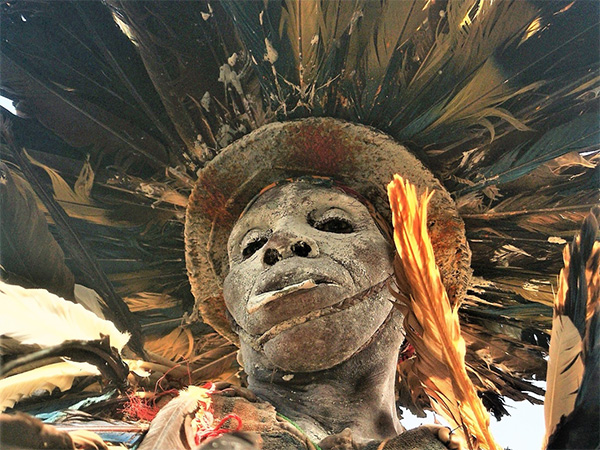
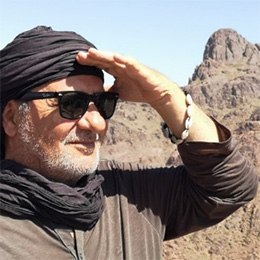 EXPEDITION LEADER: Alberto Nicheli, TransAfrica founder, has been travelling in West Africa since 1975. He has led more than a hundred expeditions in West Africa and sixty-four Sahara expeditions, including solo crossing of the desert, ethnological research on Tuareg and rock art. He has organized the logistics of a documentary film for Discovery Channel on the Caravans of the Niger and has assisted in numerous research projects on West Africa with Angela Fisher and Carol Beckwith from National Geographic, as well as in different television programs on West Africa. He has an expertise in Tribal Art and security in West Africa.
EXPEDITION LEADER: Alberto Nicheli, TransAfrica founder, has been travelling in West Africa since 1975. He has led more than a hundred expeditions in West Africa and sixty-four Sahara expeditions, including solo crossing of the desert, ethnological research on Tuareg and rock art. He has organized the logistics of a documentary film for Discovery Channel on the Caravans of the Niger and has assisted in numerous research projects on West Africa with Angela Fisher and Carol Beckwith from National Geographic, as well as in different television programs on West Africa. He has an expertise in Tribal Art and security in West Africa.
| Day 1 - 3 | Senegal |
| Day 4 | Senegal - Gambia |
| Day 5 | Gambia – Casamance ( Senegal) |
| Day 6 - 10 | Guinea Bissau |
| Day 11 - 13 | Guinea Conakry |
| Day 14 -18 | Sierra Leone |
| Day 19 - 20 | Liberia |
| Day 21 - 22 | Guinea Conakry |
| Day 23 - 28 | Ivory Coast |
| Day 29 - 31 | Ghana |
| Day 32 | Togo |
| Day 33 - 35 | Benin |
Detailed Itinerary
Day 1: Senegal
Arrival to Dakar Airport and transfer to Lake Rose.
Dinner and overnight at Trarza Hotel, facing lac rose.
Day 2: Dakar, African Metropolis (Senegal)
Lac Rose, also known as Lac Retba, is a shallow saltwater lake surrounded by dunes. Due to the high concentration of salt the lake often shimmers in pink; swimming in the lake gives the sensation of floating. More than 600 people work collecting salt from the lake, in the traditional way. Arrival to Dakar, start the visit of the town: Dakar became an important centre of political, artistic and intellectual “renouveau” during the independence, and is still a lively African metropolis. Visit of the “Plateau” district, the Presidential Palace a typical market and an interesting museum.
Ferry to Gorée Island: The right times to enjoy Gorée is at sunset when all tourists are gone or in the morning before the crowd arrival.
Dinner in a typical restaurant and overnight at “Maison Municipal” or similar. A comfortable Guest house in an ancient, restored building, Air-conditioned self-contain rooms.
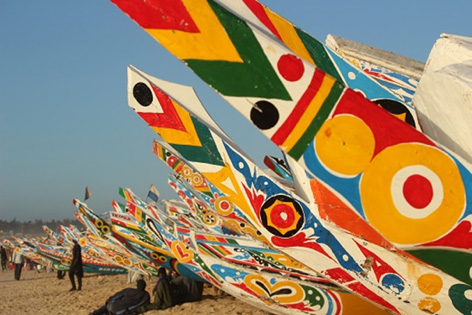
Day 3: Goree (Senegal)
In Gorée island slaves were crammed, waiting to be shipped to the Americas. Totally restored remain to bear witness of those times. Today its breezy climate, history and ancient architecture, together with nice restaurants and boutiques, make Gorée an interesting and trendy destination for local and foreign visitors. Ferry to Dakar and visit of the town.
Dinner and Overnight at the comfortable air-conditioned bungalows of Relais de Kaolak or Kabacoto Safari Lodge, facing a lake and lagoons ***, or similar.
Day 4: Gambia, Betwin Archeology and Contemporaneity (Senegal - Gambia)
Early departure, the region between the north bank of Gambia River and Senegal have hosted one of the largest megalithic civilisations on earth . Sine Ngayene is the richest Megalithic site with 1102 erected stones. Border of Gambia and a “very local” ferry crossing of the large Gambia River estuary to reach Banjul, the capital. Visit of the town centre, and the interesting national museum. Optional: music in town.
Dinner and overnight at Kairaba Beach hotel ****, swimming pool.
Day 5: Dancing Mask (Gambia - Casamance, Senegal)
Morning, brief but intense guided bird watching experience.
Departure for the border with Casamance, the southern region of Senegal.
Late afternoon we will join the ritual dances of Diola sacred mask. The masks belong to a secret society and the identity of the dancers is not revealed, it is said that the mask is animated by the spirits. Drums, dances and a colourful crowd will enliven the tiny village in the shade of larges kapok trees.
https://www.youtube.com/watch?v=zp6x2rlnNXA
Dinner and overnight at the comfortable Kadiandoumange hotel ***, located on the bank of Casamance large river, swimming pool. An interesting example of local managed charming hotel. Or similar.
Day 6: Ancestors Cult (Senegal - Guinea Bissau)
Crossing of Guinea Bissau border. The Manjaco ethnic group calls the traditions “Gendiman”. We will visit tiny villages hidden in the forest to discover the sculptured wooden poles called “Pecab” that represent the spirits of their ancestors, in a sanctuary known as “Cab Balugun”. After asking permission to the villagers, we will have the opportunity to see different generations and styles of sacred wooden sculptures; one of the last chances to enjoy tribal art in its original cultural context. Arrival at Bissau .Dinner and overnight at Azalai Hotel ****. Or similar
Day 7: Bijagos Sacred Archipelago: The Ghost Capital (Guinea Bissau)
We will start a three days spectacular navigation on a speedboat to discover the Bijagos Archipelago, his fascinating nature and isolated tribes. The Archipelago, composed by 88 islands and islets, is located at an average of 40 miles from the coastline. Bijagos is a “geographical jewel”.
Bolama was the former capital of the Portuguese Guinea from 1871. In 1941 the capital was moved to Bissau. When the Portuguese left, native people came to live in this town which is now falling apart, partly invaded with tropical vegetation. Built following the plans of a «Castrum Romane» (roman citadel) the town is made of straight large avenues, sunny and lethargic empty squares, dry fountains, bush-like gardens, imposing administrative buildings in neo Palladian style. In the shade of the columns at the former governor palace goats graze peacefully. Although inhabited, this capital town is plunged in the fairy-tale atmosphere of a ghost town.
Dinner and overnight at Ponta Anchaca Resort **** in comfortable air-conditioned wooden bungalows, hidden in the vegetation and facing the ocean. Restaurant on stilts with refined French and tropical cuisine. This lodge will be our base for two days.
Day 8: Vaca Bruto Dancing Ceremony (Guinea Bissau)
Short navigation to Bubaque island, the “capital” of Bijagos Archipelago, his market and the tiny museum.
Afternoon: due to the remoteness, the lack of transports and the deep attachment of the locals to their traditions, the Bijagos tribes have been little influenced by the external world. Life in the villages is characterized by initiations rites and secret ceremonies. In some villages, the young men must go through a seven-year initiation rite living in a “convent” with no contact with women. With its wild and idyllic landscapes, and a genuine tribal culture, Bijagos Archipelago is a “geographical jewel”. In Bijagos Archipelago life is still ruled by the “cycle of seasons”. During the long dry season, when harvest is over, the main ceremonies take place. Vaca Bruto (wild bull) is the most spectacular mask in the islands, the dancers convey the mask a realistic presence by bowing and facing the ground. With eyes of frosted glass, real horns, leather ears and a rope through the nostril. All convey the idea of a real untamed animal, representing a man in full possession of his physical strength but still with an immature behaviour as he has not yet undergone the final initiations. All the villagers attend this fascinating ceremony.
Retour to our comfortable Ponta Anchaca Resort **** in comfortable air-conditioned wooden bungalows, hidden in the vegetation and facing the ocean. Restaurant on stilts with refined French and tropical cuisine.
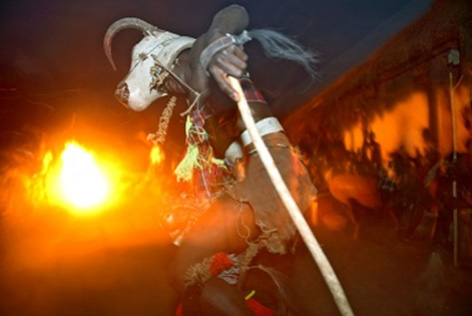
Day 9: Islander Life (Guinea Bissau)
Morning relax at Ponta Anchaca wild beaches, and swimming pool, or walking excursion in the island.
Afternoon navigation to Bissau.
On request (not included) Early morning departure for an excursion to Orango Island in search of a residual fauna of Hippos that has acclimatised with the life on islands. Mainly living is fresh-water swamps, some time they could swim in the ocean. Local guide will lead the visitors, hippos are not granted.
A vehicle will be waiting us for a brief city tour. Bissau is a tiny but intriguing capital town with old Portuguese architecture and a huge fort, a reminder of the slave trade era.
Overnight hotel Azalai, international standard ****
Day 10: Griot: The African Trobadors (Guinea Bissau)
Early morning departure. After lunch we leave the main road for a small village in the Malinké region.
The Malinké are the descendants of the ancient Mali Empire and are spread on the current territory of Mali, Guinea Conakry Ivory Coast, Senegal and Guinea Bissau. Griots are a cast of musician-story tellers dating from the Mali Empire. The village we visit is known for the Griot families that have maintained these traditions from the time of the Empire. Well-known also for their skill in producing musical instruments, they will perform a concert for us., Arrival at Gabu. Dinner and overnight at the new hotel Karsa ***, air-conditioned self-contained rooms.
Day 11: The Largest Mountain Massif (Guinea Bissau - Guinea Conakry)
A human-drawn barge will allow us to cross Rio Corubal, the natural border between the two Guineas and bring us to the small border posts of Guinea Conakry in a region inhabited by the Malinké and the Fulla (Peul) tribes; stopover in villages where the arrival of foreigners is a very rare event.
Joint the main road we will start to penetrate Fouta Djalon massif. Thanks to the fresh and salubrious climate was the preferred place by the French for their holidays during the colonial era. Wood of conifers is left as memory of that time. Considered the most spectacular area of Guinea: mountains, plateau and savannah are alternated with deep humid valleys. This large mountain massif is the “water reservoir”, from Guinea starts 3 rivers that give name to four nation: Niger, Nigeria, Senegal and Gambia. On this territory live the Fulani, famous for their beauty and considered the greatest stockbreeders of cow of the West Africa. We will visit isolated villages, composed of large clay houses decorated with bas relief, high conical roofs with several layers of straw.
Evening arrival to Labe and overnight at the basic but comfortable and clean Hotel Tata, self-contain bungalows with A/C.
Day 12: Fouta Djalon (Guinea Conakry)
Full day dedicated to discovering Fouta Djalon where the mountains meet the savannah, deep valley, highest waterfalls framed by the forest make the landscape of a pristine beauty. Peul ethnic group, (called also Fula’s) come from this area; Peul are known for their beauty and for being the best zebu breeders of West Africa. In the XVII century the Fula’s (Peul) Jihad started from these mountains and they led the Peul to conquer the majority of savannah till Cameroun and are the largest group in sub-Saharan savannas. A very large clay round hut with a decorated grass roof is where the main council sits and where were nominate the traditional chiefs of all Fouta Djalon, thanks to our connections we will ask to be received by chiefs and dignitaries siting in council….
Arrival at Dalaba at 1200 m. ( 3900 Ft.) altitude. Dinner and overnight at a new and comfortable hotel, Safitel ***. Air-conditioned self-contain rooms.
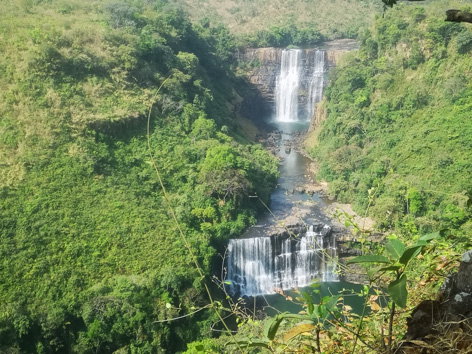
Day13 : African Bas-Relief (Guinea Conakry)
Visit to Dalaba small and quiet town. Of an interest is the “casa a palabra” (the house of words) with fine bas-relief in a pure Peul architectonical style. Here the chiefs used to gather to meet the colonial administration.
Visit to the villa built by the colonial governor and later used by the first president of independent Guinea. The leader of the independence was Sekou Touré, one of the most radical anti-colonials; he refuse any cooperation with French and linked Soviet Union bloc and tide friendly relationship with Ceausescu. Under Sekou Touré, the country became more and more isolated and the government turned into a dictatorship. Some villas used by the ministers and by the guests of Sekou Touré are reminiscences of that time. In a today ruined villa Miriam Makeba met and married Stokley Carmichael, an exile from the US who was among the inspirators of the armed wing of Black Panter.
We will live Dalaba following the southern slope of the massif to reach Mamou an interesting trading town and his market.
Hotel Balys , or similar. Basic comfort Air-conditioned Self-contain rooms.
Day 14 & 15: Masks In The Forest (Guinea Conakry - Sierra Leone)
A tiny small track will bring us to a small border with a remote area of Sierra Leone, arrival at the village of Kamakwie, in this region, where foreigner are rare, if lucky we will assist to traditional dances and the exit of sacred masks, called here “devils”.
Next day drive in the direction of Freetown peninsula.
Day 16: Freetown Peninsula (Sierra Leone)
Freetown origins: in 1786 the first 308 freed slaves came to Sierra Leone from America where they have fought in the independence war on the side of the British, after having lost the war the British sent them to Sierra Leone. Few months after their arrival, the newcomers were starving, got new and unknown diseases and fight with the locals, who hardly stand them. Few years after during a Napoleonic war, Freetown has been attacked by seven vessels of the French navy and destroyed. Few survivors escape on the pirogues sent by… the slaves’ traders… From 1807, due to the abolition of the slave trade by the British Empire, the ships of the slave’s traders caught by the British navy freed the slaves in Sierra Leone.
In 1808 Freetown became the capital45 of the first British colony in tropical Africa. At that time Krio, or ex slaves, were more than 50.000 creating an elite who put pressure on the colonial administration for a better education. In 1845 was built Fourah Bay the first University in west Africa. During Colonial time Freetown was known as the “Athens of West Africa”. Drive along the coast at the slopes of the Freetown peninsula mountains… only the yellow of the beaches divide the green of the lush vegetation from the blue of the ocean. The country has been named after these mountains, the mountains of lion. A local boat will bring us to Banana island. Dinner and Overnight at the cozy Bafa Lodge that will be our base for two nights: fix tents hidden in the forest facing the sea. Fine cuisine based on the catch of the day (other meals available, ask in advance).
Day 17: Banana Island (Sierra Leone)
Full day dedicated to circumnavigating, explore, walk and discover this pristine island with mountains in large primary forests, villages and remote beaches. For the more adventurous a half day walk to explore the forest or continue the circumnavigation of the island. Lunch picnic, dinner and overnight at our unique Bafa Lodge fix camp.
Day 18: Bundo: Female Masks (Sierra Leone)
Brief navigation, to joint our vehicles and departure in direction north east.
In most parts of Africa, the masks are male’s prerogative, however among the Mende people and neighbours populations the masks Bundo are a female’s domain and they have crucial role in the initiation rites. We reach a tiny village to assist at the exit of these masks, an event that calls for the participation of a colourful crowd.
Dinner and overnight at comfortable hotel Dohas, rooms with A/C and en-suite, or similar.

Day 19: Diamonds (Sierra Leone - Liberia)
Diamond searching is as addictive as gambling at least, the possibility of finding a “fortune” can become true for most lucky. Diamonds have played an important role in the recent troubled history of the country and the quantity and quality of “stones” to find is important. We will take a track to reach a village with huts made by clay and straw. After asking permission to the chief some villagers will take us to the site where we can meet the diamonds’ seekers. The local person will explain us the technics of artisanal mining and “sand washing”. A spectacular road in the forest will bring us to the Mano River the natural border with Liberia. After the border formality we will continue to reach Monrovia in the evening. Diner and overnight at the comfortable Cape Hotel **** international standard, at Mamba Point, in the best area of Monrovia. Or similar.

Day 20: Liberia: The Land of Freemen (Liberia)
Liberia is the only African country which has never been either a colony or a protectorate; Liberia was founded by Krio, the freed slaves who came back to Africa from America, for this reason was named “Liberia”. Krio are 5% of the population and they are the main actors of the economy and politics, they are considered the creator of the Nation and of the modern economy . 80% of the population speaks the Krio language, a sort of American English “Pidgin”.
Our ocean-view hotel is the best starting point to visit town. Freemasonry had a great impact on the history of Liberia and Krio culture, visit of the Grand Masonic Temple imposing building. A symbol of Monrovia is what left of the Ducor Palace Hotel, inaugurated in 1960 was one of the first five stars in Africa. Located on a rocky hill in the highest point of Monrovia, dominate the whole town and the gulf. The hotel hosted social events and parties of the African political elite at the time of independence. In the large swimming pool facing the ocean Idi Amin used to swim caring his gun at the belt while his friend Miriam Makeba was singing. After the civil war the building was looted several times, the hotel is now abandoned and closed, but seeking the right permission, we may be able to visit it.
In 2008 the government made a deal with Ghaddafi to rebuild this hotel, however the project, as many other Libyan development projects, never came to conclusion thanks to the war that Europe and America made to overthrow Ghaddafi.
The building of the National Museum his himself a display of Krio traditional architecture, inside we discover a large collection of ancient masks and ritual objects and a photographic show about the civil war which took place between 1989 and 2003. Old colonial buildings, stone Krio churches will be also part of this intriguing town visit.
Lunch and departure for Gbarnga. Dinner and overnight at Passion 2 Hotel ***, or similar.
Day 21: African Wild Forests (Liberia - Guinea Conakry)
Early morning departure for a day of driving to the northern part of Liberia and to the greatest forest region in Guinea Conakry. Crossed the border we will continue through larges rubber plantation (hevea) to reach Nzerekore and Macenta in a hilly and luxuriant landscape. After dinner we live the hotel to join a village and participate to a spectacular dance: the masks will live the forest and dance at the light of a large fire….
Dinner and overnight at the comfortable and new Hotel Macenta *** fully air-conditioned, self -contain rooms, swimming pool. Or similar.

Day 22: Bird Men, Toma Masks & Liana Bridge Guinea Conakry
A small track in the lush vegetation will bring us to a remote village to assist at one of the more spectacular, and les known, sacred dances of West African forests. The Bird Men with the face painted in Kaolin and totally dressed in feathers belong to a special initiation, that has passed secretly from father to son during centuries. Believed to have magical powers that can make him invisible, the bird men are during tribal wars, the best messengers, able to cross the enemy lines. Tom-tom drummers and all the village will participate to the event. Toma localy called Loma have also different masks living in the sacred forest…
This region hides many secrets. The liana bridges are masterpiece of an authentic "tribal technology" and can measure 70-meter length. They are built exclusively with vegetal materials, as wood and lianas without the use of nails or rope nor other materials foreign to the forest. Only the initiated can harvest the liana and wood and leave it in the forest, is believed that a powerful spirit will build the bridge in one night. During the preparation of a new bridge needier women nor not initiated are allowed in the forest, to guarantee the secrecy of this "magic technology".
Arrival to Nzerekore after an intense day. Dinner and Overnight at hotel Bethanie, self-contain air-conditioned rooms.
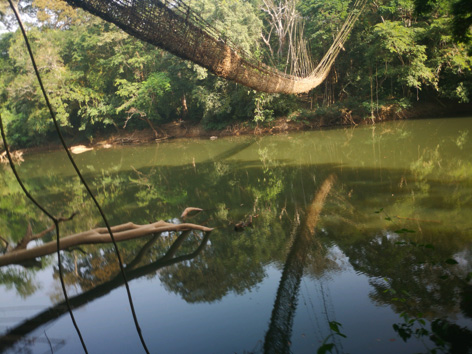
Day 23: Primates (Guinea Conakry - Ivory Coast)
Early morning departure from Nzerekore, the main settlement of the Forest Region. We reach Bossou village in time for a walk to discover a forest, where a group of chimpanzees (Pan Troglodytes) lives. The inhabitants consider them the reincarnation of their ancestors and therefore hunting them is forbidden. The chimpanzee are constantly monitored by the researchers and therefore they are easy to approach.
The road will bring us to Ivory Coast border. When mount Tonkpi with its pic comes into view we are close to our destination. The small town of Man, surrounded by 18 green mountains is the capital of the We, Dan and Guéré ethnic groups known for the mask considered between the masterpiece of African Art. We will spend two nights at our hotel in Man. Dinner and overnight at hotel Les Cascades, air-conditioned self-contain rooms ***, swimming pool. Or Similar
Day 24: Dan Masks (Ivory Coast)
Full day dedicated to Man region. In a nearby tiny village, masks will emerge from the forest towards us. In the cosmogony of the Dan people, there is a creator god that communicates with humans only through its intermediaries, the masks: during the mask dance the distance between the human and the spirit worlds disappears, the cosmic and the social orders are restored, and gratitude is expressed to the gods and the ancestors. Dan Masks are one of the finest tribal mask thanks to the delicate balance of shapes that symbolize beauty.
Man, market is an important market with villagers coming from the region and from the neighbours countries. It will be possible to find a wild choice of handicraft and, with some luck, authentic tribal masks and ritual objects. Dinner and overnight, return to hotel Les Cascades, air-conditioned self-contain rooms ***, swimming-pool. Or similar.
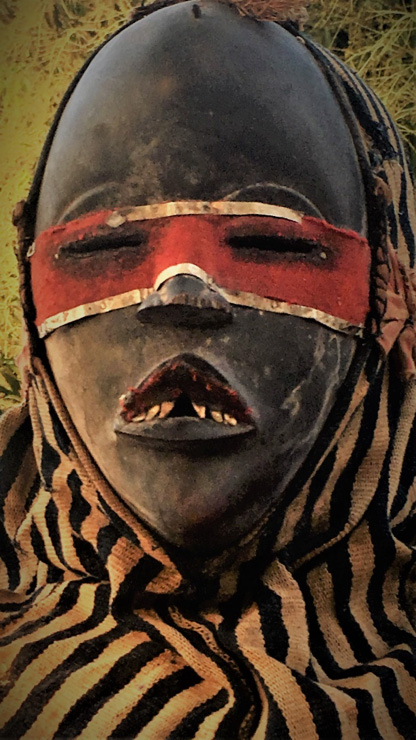
Day 25: Magic Traditions (Ivory Coast)
Full day dedicated to discovering masks and magic traditions.
Only 4x4 vehicles drive at remote villages in the forest to encounter the Guere ethnic group, where the arrival of foreigners is a rare event.
https://www.youtube.com/watch?v=4-_vPJqtxyA
We will discover the powerful Guéré Mask dances, and (if we are lucky) the rare “Jugglers” performances. Girls initiatory Juggling is an ancient tradition now vanishing and we have been able to discover one of the last villages where is still practiced.
If Dan’s masks are considered among the more refined example of beauty and aesthetic, Guéré masks are known for the powerful and rough aspect. Return to the main road to reach the town of Daloa in the evening. Diner and overnight at the recent Hotel La Grace, self-contain airconditioned rooms ***, or similar.
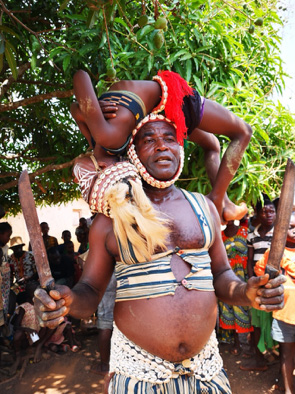
Day 26: Cathedral In The Savannah (Ivory Coast)
Day of drive in south-east direction. We continue our journey across coffee and cocoa plantation, dotted only by small villages. Ivory Coast is the world’s main cocoa producer, the second is Ghana and together, they represent more than half of the world production.
In a village we attend the Zaouli dancing masks. Zaouli is a traditional dance of the Guro tribe. The Zaouli mask, was created in the 1950s, probably inspired by a girl named "Djela Lou Zaouli". However, stories on the origins are varied, and each mask can have its own symbolic history. The uniqueness of Zaouli dance is the fine and sophisticated movement of the legs and the fits.
https://www.youtube.com/watch?v=dDYN2D4MvOM&list=PL3fWcyxhXJem5SB-CrAPiBevgyzVhSKWV&index=44
Afternoon arrival to Yamoussoukro, the country’s formal capital since 1983, is the native village of Houphouët-Boigny, the first President of the Ivory Coast. Here the Ivorian dream of the 1970s and 1980s has come true, the dream of a country that, despite its shortage of major natural resources, has create the largest economy in French west Africa.
We visit the Basilica of the Virgin of Peace, inspired of St Peter’s in Rome, is the largest building of Christianity on earth, unique the high colourful glass windows. We see wide boulevards where the few cars try to avoid the big potholes, Zebus and chickens. The huge government buildings, the lofty hotels up to 14 floors high, and even an artificial lake inhabited by crocodiles have a feeling of abandoned.
Dinner and overnight at the comfortable Royal Hotel, swimming pool, *** air-conditioned self-contain rooms, or similar.
Day 27: Abidjan, Skyscrapers and Lagoons (Ivory Coast)
Motorway departure for Abidjan that we will reach late morning. Beyond the lagoon, the “plateau” (the City District) is growing very fast, not horizontally as in most African towns but vertically, with its large modern buildings and skyscrapers. Not much land is available and the little available must be continually recovered from the waters of the Ebrié Lagoon. The modern City District is defined to the west by the harbour and its endless queues of people waiting for a public boat, and to the east by the silhouette of Saints Peter & Paul Cathedral. Chaotic traffic is the negative result of the fast-economic development of this country that after the civil war has some time reached the 6% of the GDP. https://www.youtube.com/watch?v=XpvcvYRQbhA
31st December, great gala dinner and dances at the hotel, celebrating new year in the typical Abidjan’s way! Overnight at the comfortable and new Azalai **** hotel, international standard, or similar.
Day 28: Grand Bassam (Ivory Coast)
Drive to Grand Bassam: old Town built on a sand bank between the lagoon and the ocean. It was the former capital of the French Ivory Coast colony and now a maritime leisure resort for the Abidjanese. Thanks to its calm avenues shaded by tall trees, large bougainvillea and well-preserved colonial buildings, Grand Bassam has a magic atmosphere. The old post office is a jewel of colonial architecture. The Costume Museum, in the former governor’s palace, with its large outer staircase is a true architectural gem and its unique collection of tribal costumes, masks, ornaments and ethnographic photographs gives an interesting perception of the country history and culture. Continuation in direction East to the small town of Aboisso.
Dinner and overnight at Hotel le Rochè***, Self-contain airconditioned rooms, or similar.
Day 29: Gold Coast (Ivory Coast - Ghana)
Early departure, drive to the Ghana border. In Axim visit fort St Antonio built by the Portuguese in 1515 at the estuary of Ankobra River in a region rich in Gold. The coast of Ghana is unique in whole Africa for the concentration of ancient castles and forts. More than 80 fortifications where built by Europeans during three centuries, to trade in gold, ivory and slaves. The name of this region, from the first Portuguese navigator that discover it navigators in 15th century to the independence in 1957 was named Gold Coast from the abundance of the gold traded. Evening arrival at Anomabu Beach resort where we will spend two nights. Air-Conditioned self -bungalows near the ocean. 31decemberv Gala dinner, in the African joyful stile.
Day 30: Elmina Unique Atmosphere (Ghana)
Full day dedicated to discovering ancient slave trade castles and syncretic animistic shrines.
After a stop at Cape Coast we will visit Elmina Castle, the oldest European building in Africa. Sao Jorge da Mina was erected by the Portuguese in 1482. At different times the castle has been used as a warehouse to trade gold, ivory, and eventually slaves. The castle we visit today is the result of successive extension works and is recognized as a UNESCO World Heritage site. Facing the castle, the fishing harbour with hundreds of colourful and large fishing wooden canoes. In the old town and neighbours, we will discover the Posuban, shrines of the “Asafo companies” where the Asafo “warriors” still pour libations. The alleys in the old town have a unique atmosphere, bringing us back long time before the colonial era when Elmina was the first place of fix exchanges between Europeans and Sub Sahara Africa. Dinner and overnight: return to our bungalows at Anomabu Beach Resort, or similar.
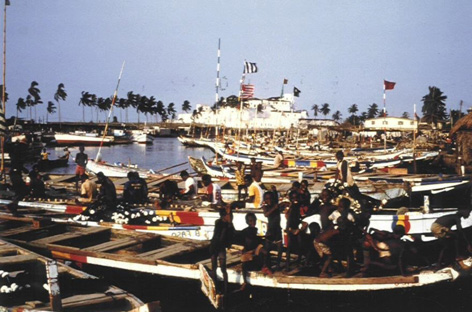
Day 31: Accra “The Capital” (Ghana)
The capital of Ghana has maintained its special identity despite the fast-paced development currently underway in this intriguing African vibe. We explore the old of James Town area, inhabited by the local population known as the Ga. Our tour ends with the visit of a workshop where they specialize in building fantasy coffins. These special handcrafted coffins can take on any shape: fruit, animals, fish, cars, airplanes…. the only limit being imagination! Dinner and overnight in the town central district at Villa Boutique *** self-contain air-conditioned rooms, or similar. Optional, swinging Accra: evening at one of the more typical music club in town.
Day 32: Lome: Cosmopolitan And Stylish Capital (Ghana - Togo)
Morning drive to Togo border.
Lome, the vibrant capital of Togo, is the only African city which has been ruled a ruled by Germans, British and French and has attract traders from different African countries. It is also one of the rare capitals in the world bordering another nation. These elements have developed a unique lifestyle of its inhabitants, of is multi facet cuisine and is the architecture. Lome is a meeting point for people, trade and cultures, a cosmopolitan, but still in human size capital. We will visit: the central market with its famous “Nana Benz”, women who control the market of the expensive “pagne” (colourful cloths) sold all over West Africa the colonial buildings and the largest “fetish market” in whole Africa, where we can find an eclectic assortment of all the necessary ingredients for love potions and magical concoctions.
Overnight at the recent Onomo Hotel***, or similar.
Day 33: Voodoo (Togo -Benin)
Voodoo is the main religion in the coastal area of Togo and Benin and authentic ceremonies are common: the frenetic rhythm of drums and the chants of the adepts “call” the Voodoo spirits who takes possession of some participants. The possessed falls into a deep trance: eyes rolling back, grimaces, convulsions, insensitivity to fire or pain. Sakpata, Heviosso, Mami Water are just some of the voodoo divinities who can manifest... Surrounded by the magic atmosphere of the ceremony, we will understand what people mean when they say: “In your Churches you pray God; in our Voodoo shrine we become Gods!”.
https://www.youtube.com/watch?v=YuZlf-iyqM8 Border with Benin and arrival to the small town of Grand Popo. Dinner and overnight at the charming Auberge dev Gran Popo, ocean front ancient colonial building totally restored. Air-conditioned self-contain rooms. Or similar.
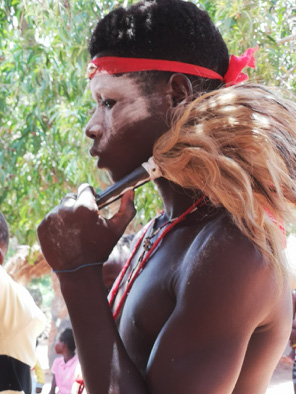
Day 34: Ouidah, Afro-Brasilian Culture (Benin)
Between lagoons and ocean, we will discover Zangbeto cult. Zangbeto Mask Is very tall and covered with coloured straw. It represents wild, non-human spirits (the forces of nature and of the night that inhabited the Earth before human). The mask wearers belong to a secret society and keep their identity hidden as the non-initiated cannot know who they are. When Zangbeto dances is an event for the village. Its performance guarantees protection against bad spirits and witchcraft. The spinning movement of the mask symbolizes the spiritual cleaning of the village and Zangbeto also performs « miracles » to prove it powers.
https://www.youtube.com/watch?v=LUKuOSTTXlY
Drive to Ouidah, this small town was conquered by the Dahomey Kingdom during the 18th century to become one of the main slave ports. We the start visit following the “slave road” to the beach, the point of “no return” where slaves were shipped to the “new world”. Ouidah enjoys a rare Afro-Brazilian architecture, where the python temple faces the Catholic Cathedral. The laid-back attitude of the locals blends in harmoniously with the thunder of the distant waves and the rhythm of the drums - a timeless atmosphere well described by Bruce Chatwin in his book "The Vice-Roy of Ouidah". On foot we visit the Python Temple and the Portuguese Fort, now a small but interesting museum on the history of Ouidah and the transatlantic slave trade and the links that this trade have created between Guinea Gulf countries and the Caribbean. Dinner and Overnight at Hotel Casa del Papa **** or similar, ocean front bungalows, wild beaches, swimming pool. (Air-conditioned bungalows en suite).
Day 35: The Stilts Village (Benin)
Drive for miles on the fisherman track between endless yellow beaches, tall palm trees straw huts and colourful pirogues. We will leave our vehicles and cross Lake Nokwe on a motorized boat to reach Ganvié, the largest and most beautiful African village on stilts. The approximately 25,000 inhabitants are part of the Tofinou ethnic group and build their wooden houses on teak stilts. Breeding fish with an ancient tribal technology is their main activity. Ganvié has managed to preserve its traditions and environment despite the long-lasting human presence in a closed setting; and the lake is not over-fished. Daily life unfolds in the dugout canoes that adults and children row with ease using brightly coloured paddles. From these canoes men fishing, women expose goods at the “floating market”, children go to school and play, in Ganvie children are said to learn to swim first than to walk.
Day room available in Cotonou and transfer to the airport.
EURO Rates per person in sharing double
Full Expeditions from Dakar to Cotonou:
35 Days Across West Africa, DAKAR - COTONOU
Start in Cotonou February 26th, 2021. End in Dakar April 1st, 2021. REVERSE ITINERARY
Start in Dakar December 12th, 2021. End in Cotonou January 15th, 2022.
Start in Cotonou March 5th, 2022. End in Dakar April 8th, 2022. REVERSE ITINERARY
Start in Dakar December 11th, 2022. End in Cotonou January 14th, 2023.
Group of 6 or more participants: 8,758 €
Group of 4 to 5 participants: 10,860 €
Single room supplement : 1,194 €
Or join for part of the expedition:
Download Full Trans-Sahara & West Africa Expedition / Legs of the Expedition - Dates & Rates [pdf]
Prices include:
- Transfer airport/ hotel and hotel/ airport at arrival and departure, EXCEPT for the first day from the airport to the hotel In Marrakech. The fixed price for a taxi from the airport to any hotels in Marrakech is 200 Dirhams or 20 Euro.
- Full board during the expedition. Lunch on the last day.
- Drinks at meals during the nights in the mobile camp. No alcohol in Mauritania
- Transfers and tour in 4WD vehicles, minibus, speadboats
- Tour Leader (languages spoken: English, French and Italian)
- Tours and visits as per the program
- Participation cost to events, as scheduled
- Accommodation as per the program
- First aid box
- All services included in the program
Prices do not include:
- International flights
- Transfer from Marrakech airport to the hotel in Marrakech on day 1.
- Visas
- Dinner on the arrival and departure day
- Drinks and mineral water at meals, except for those at the nights in the mobile camps
- Portage
- Fees for personal photos and videos
- Personal insurance (compulsory)
- Tips for drivers, guides and hotel staff
- Any item of personal nature such as phone calls, laundry, etc.
- Whatever is not mentioned as included




